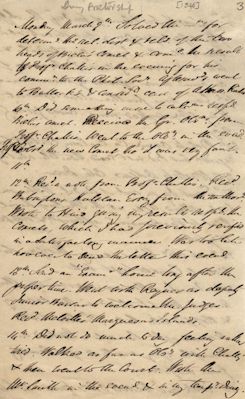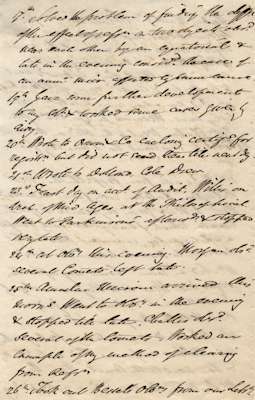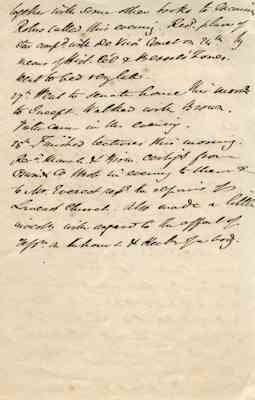|
|
THE FORGOTTEN
DIARY OF
JOHN COUCH ADAMS
 A
fragment of Adams' 1846 diary remains, for the month of March, never
quoted or even mentioned by historians. This may reflect upon some
difficulty of access to the John’s College archives, for it
has been there all along! It gives a day-by day account of the life
of a Cambridge astronomer, showing a close liason with James Challis,
seventeen years older than him, working at the Observatory just
outside town, a pleasant stroll from his College. The diary-fragment
has two days for 1844 (these describe Challis visiting Adams twice
within four days) and fifteen for March of 1846, of which about
half allude to Challis and/or the Observatory at Cambridge. That
for February 12th, 1844 shows Adams grappling with a cometary paths: A
fragment of Adams' 1846 diary remains, for the month of March, never
quoted or even mentioned by historians. This may reflect upon some
difficulty of access to the John’s College archives, for it
has been there all along! It gives a day-by day account of the life
of a Cambridge astronomer, showing a close liason with James Challis,
seventeen years older than him, working at the Observatory just
outside town, a pleasant stroll from his College. The diary-fragment
has two days for 1844 (these describe Challis visiting Adams twice
within four days) and fifteen for March of 1846, of which about
half allude to Challis and/or the Observatory at Cambridge. That
for February 12th, 1844 shows Adams grappling with a cometary paths:
'Prof Challis brought one of the Notices of the Astr. Socy. containing
my results respecting the Comet.'
In January of 1846 there appeared 'a phenomenon which struck every
astronomer with amazement' to quote Herschel: a comet divided into
two (Herschel, Outlines of Astronomy, 1849, p.359). Such a thing
was hitherto unheard-of and created a sensation. But quickly Adams,
as his diary records for March 9th, 1846:
 '...solved
the equations for determining the relative distance and velocities
of the two heads of Biela's comet and communicated the results to
Professor Challis, in the evening for his communication to the Philosophical
Society' [a Cambridge club, of which Challis was then the President]. '...solved
the equations for determining the relative distance and velocities
of the two heads of Biela's comet and communicated the results to
Professor Challis, in the evening for his communication to the Philosophical
Society' [a Cambridge club, of which Challis was then the President].
The next day Adams improved his comet calculations, receiving some
more data from Challis and then going in the evening to the Observatory
to view the comet.
March 14th found him weary:
'Did not do much today, feeling rather tired. Walked as far as Observatory
with Challis & then went to the Courts.'
- he does not walk to the Observatory to meet Challis, as one might
expect. (Challis was then living at the Observatory, as the Plumean
astronomy professor there, while Adams lived at St John's College
a mile or so away). He reports on his work to Challis, Challis comes
round to his house, and he stays at the Observatory 'till late'.
On March 19th, he is
'finding the differential effect of refraction on two objects observed
near each other by an equatorial', where he 'worked some cases given
by Airy'. 
Six out of the 15 days of 1846 mention Challis and/or the Observatory;
while adding the 1844 fragments gives 8 out of 17. One is surprised
at the way all previous commentators have ignored the diary of the
co-predictor of Neptune over the very year of its discovery. 'Adams
was his own private friend' wrote Mrs Airy of Challis (writing to
Sedgwick 9th December 1846). The recent biography of Adams only
starts quoting from his diaries one decade later, and, in common
with earlier accounts, gives no hint of any special friendship with
Challis.
Hind wrote to Adams on Feb.28, 1846 discussing details of Biela's
comet, 'as you state in your note received yesterday.' Biela's comet
was of short period and had been seen only once before. It returned
as a double-comet in 1852, and thereafter gave rise to a meteor-shower,
the Andromedids.
As to why all of Adams' 1845 and the rest of the 1846 diaries are
missing, though in general 'He hardly destroyed anything he wrote'
as Glaisher observed (Preface to Adams’ Scientific Papers,
1986), I suggest that Adams had no wish for a record of his close
liason with Challis to endure, but on the other hand he did want
to record his working on 'Biela's comet' and the finding of his
method to clear atmospheric refaction from telescope observations.
These were used (presumably) by Challis and Airy for their telescopes,
and both were recorded in his March entries. In February he corresponded
with the astronomer Hind about the comet, receiving on the 28th
a letter from Hind and then in April gave his address to the RAS
about it.
Challis’ Report to the Cambridge Board of Governors on 12th
December 1846, in his capacity of Director of the Observatory, affirmed
of the period between Autumn 1845 and midsummer 1846, ‘I had
little communication with Mr Adams respecting the new planet.’
(Adams Scientific Papers, p.li). One is startled by such outright
mendacity from a reverend. The diary-fragments strongly indicate
that Challis was closer to Adams, over this period, than was anyone
else (except, possibly, his family). They were seeing each other
every few days and Adams would often stay ‘till late’
at the Observatory. Later on, they together dreamed up the blissful-sounding
name ‘Oceanus,’ and Challis proposed it! (Athenaeum,
Oct 17th p.1069) Then, in his Nov. 3rd letter to Airy, Challis feels
able to speak on Adams' behalf to Airy, about the big meeting coming
up: '...I can give no hope of Adams being able to undertake the
Astronomical Report'.
Both Challis and Airy strove to give the impression that they hardly
knew Adams, while simultaneously giving him credit for one of the
greatest astronomical discoveries ever. Why would they want to do
that?
|
